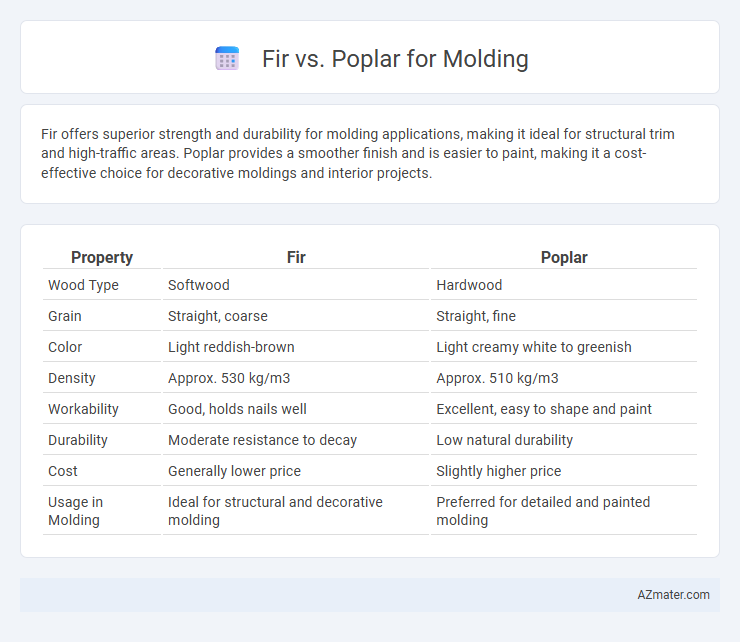Fir offers superior strength and durability for molding applications, making it ideal for structural trim and high-traffic areas. Poplar provides a smoother finish and is easier to paint, making it a cost-effective choice for decorative moldings and interior projects.
Table of Comparison
| Property | Fir | Poplar |
|---|---|---|
| Wood Type | Softwood | Hardwood |
| Grain | Straight, coarse | Straight, fine |
| Color | Light reddish-brown | Light creamy white to greenish |
| Density | Approx. 530 kg/m3 | Approx. 510 kg/m3 |
| Workability | Good, holds nails well | Excellent, easy to shape and paint |
| Durability | Moderate resistance to decay | Low natural durability |
| Cost | Generally lower price | Slightly higher price |
| Usage in Molding | Ideal for structural and decorative molding | Preferred for detailed and painted molding |
Introduction to Fir and Poplar for Molding
Fir is a softwood commonly used in molding due to its strength, straight grain, and ease of staining, making it ideal for structural and decorative applications. Poplar, a hardwood, offers a smooth texture and uniform grain, excelling in painted moldings because of its excellent paint adhesion and minimal bleeding. Both woods provide cost-effective options, with Fir favored for durability and Poplar preferred for fine finishing in interior trim work.
Wood Grain and Aesthetic Differences
Fir molding features a straight, pronounced grain with a warm, reddish-brown hue that enhances traditional and rustic designs, while poplar molding offers a smoother, more uniform grain with a lighter, creamy white to pale green color, ideal for painted finishes. Fir's richer texture and natural variations provide a classic, detailed appearance, whereas poplar's subtle grain and consistent coloration create a sleek, modern look. Woodworkers prefer fir for visible, natural wood aesthetics and poplar for customization through staining or painting.
Hardness and Durability Comparison
Fir offers moderate hardness with a Janka rating around 660, making it suitable for molding that requires moderate resistance to dents and wear. Poplar has a slightly lower Janka hardness of about 540, resulting in a softer surface that may dent or scratch more easily during installation or use. Fir's greater density and natural resin content contribute to better durability and longevity in molding applications compared to the more pliable and less durable poplar.
Cost Effectiveness: Fir vs Poplar
Fir offers a more cost-effective solution for molding due to its widespread availability and faster growth rate, which reduces material expenses. Poplar, while slightly more expensive, provides a smoother finish and ease of painting that can lower labor costs in detailed projects. Choosing fir can minimize upfront costs, whereas poplar may offer better long-term value in finish quality and versatility.
Workability and Tool Compatibility
Fir offers excellent workability and is compatible with most hand and power tools, making it ideal for detailed molding projects. Poplar is softer and easier to machine, providing smooth cuts and reducing tool wear, which enhances efficiency in molding applications. Both woods accommodate common woodworking tools, but Poplar's fine grain allows for cleaner finishes and easier staining in decorative moldings.
Paintability and Staining Properties
Fir offers excellent paintability due to its smooth, even grain, allowing paint to adhere well and produce a consistent finish on moldings. Poplar also provides good paintability but tends to absorb stain unevenly because of its varying grain density, making it less ideal for staining applications. For moldings requiring uniform staining, Fir is preferred, while Poplar excels when primed and painted for vibrant, durable finishes.
Environmental Impact and Sustainability
Fir and Poplar both serve as popular choices for molding, yet Fir is often preferred for its superior sustainability credentials due to its faster growth rate and abundant availability in North America. Poplar, while also renewable, generally requires more processing and has a shorter lifespan in interior applications, which may increase its environmental footprint over time. Choosing Fir typically supports reduced deforestation pressures and promotes eco-friendly building practices through its carbon sequestration benefits and lower transportation emissions.
Common Applications in Molding
Fir is commonly used in molding for its strength and durability, making it ideal for structural and baseboard moldings in residential and commercial buildings. Poplar is favored for intricate and decorative moldings due to its smooth grain and excellent paintability, often used in crown moldings, window casings, and custom trim work. Both woods provide cost-effective solutions, but poplar's ease of finishing makes it preferred for detailed interior moldings requiring a refined appearance.
Maintenance and Longevity
Fir offers greater durability and requires less maintenance compared to poplar, making it a preferred choice for molding exposed to wear and tear. Poplar is softer and more prone to dents and scratches, necessitating more frequent repairs and refinishing to maintain its appearance. Fir's natural resistance to decay and better structural stability contribute to its longer lifespan in molding applications.
Choosing the Right Wood for Your Molding Project
Fir offers superior strength and fine grain, making it ideal for durable, smooth molding that can hold paint well, while Poplar is valued for its affordability, easy workability, and consistent texture that absorbs paint evenly. Choosing Fir is beneficial for high-traffic areas requiring robustness, whereas Poplar suits intricate designs and cost-effective projects. Consider project location, desired finish, and budget when selecting between Fir and Poplar to ensure optimal durability and aesthetic appeal in molding.

Infographic: Fir vs Poplar for Molding
 azmater.com
azmater.com